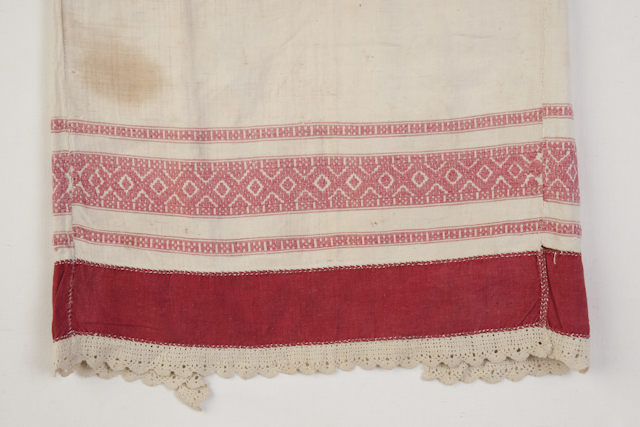Today I will present another Votic costume also from the western part of Ingria. This costume is simpler than the others, and has little in common with them except for the style of embroidery. It does have some resemblance to South Russian and Chuvash costume, which I find no explanation for. Remember that Russia only annexed this area in about the year 1700.
The specimens which I will show have been collected in the districts of Narvusi, Soikkola, and Kattila.
This costume consists of a sleeveless chemise with a shirt over it. This basic concept is quite widespread, being found in Estonia, Sweden, south Russia, and as far away as Moravia. Usually the shirt or blouse is quite short, leaving the chemise showing on the midriff, and the blouse ending just below the bust. The top garment is often simply called 'sleeves'.
The paita or chemise for this costume is quite plain. Here are a couple examples, front, back, and hem.. The hem is sometimes ornamented with hemstitch, but these are usually very plain.
The upper garment is called päällyspaita, or sometimes peretnikka, this second term is derived from the Russian 'perednyk', which means 'that which hangs in front' or apron. Aprons with sleeves are common in Russian costumes south of Moscow, but they are not known from the north. I suspect that the garment was once common among the Finnic peoples, and as they became assimilated by the Russians, passed into the folk costumes of the Russians, but only survived among the Votes in this one area in the north, where the sarafan became the dominant garment of the Russians within the last 300 years or so.
The päällyspaita has s straight cut, with long sleeves. There is minimal ornamentation around the neck opening and sleeve ends. The bulk of the ornament is concentrated on the bottom edge. For ease of movement, there is a slit up the back, ending in a keyhole shape. Sometimes there is a ribbon attached to the top of this opening. The overall length varies somewhat. Here is one example.
Here is a mannequin wearing this outfit, front and back.
The embroidery is that sort of Holbein stitch which has become typical of northwest Russia in general. Several more examples, some of which are longer.



These examples above have all been from the district of Kattila. Here are a couple from Soikkola. This first one has a ruffled cuff and ribbon ties front and back.
And a couple of examples from the district of Narvusi. This first one has darning stitch embroidery instead of the Holbein stitch.
Girls in this region wore caps covered with beads, metal plates and cowries, looking very similar to those worn by Chuvash girls.
Women wore a taller cone shaped cap with an opening on top, again reminiscent of Chuvash headgear. The symbolism of girls having a closed cap and women having an open one is obvious.

It appears that an embroidered cloth is wrapped around the women's cone shaped headdress.
Take a look at the last photo in this article, and also these.
A red beaded ornament may be worn around the neck.
Some of my sources say that women also wear a skirt, but I have been unable to find more information than that. If anyone has more information about this costume, please let me know.
I have only been able to find a couple of photos of this costume being worn.
These girls are wearing yet another shorter sleeved blouse over the päällyspaita, but I question this, as most of the museum pieces have embroidery around the neck opening and cuff.
If anyone has more information, please contact me. I feel like I have insufficient data, but I also felt that what I have been able to represent is very interesting as is.
Thank you for reading, I hope that you have enjoyed this, and that you may be able to use some of these designs or concepts in your creative life.
Feel
free to contact me with requests for research. I hope to eventually
cover all of Europe and the Former Russian Empire/Soviet Union. I also
gratefully accept tips on source materials which i may not have. I also
accept commissions to research/design, sew, and/or embroider costumes
or other items for groups or individuals. I also choreograph and teach
folk dance.
Roman K.
email
Source Material:
Most of this material is from the Finnish Museums Online website.
http://suomenmuseotonline.fi/en
L. Molotova, 'Folk Art of the Russian Federation', Leningrad, 1981
Ildiko Lehtinen, 'The Finno-Ugric Collections at the National Museum of Finland', Forssa, Finland, 1990







































Thank you for your wonderful posts Roman. I've spent several hours today on the Finnish Museums website, charting some of the embroideries shown there. Just fascinating.
ReplyDeleteVery nice, пит лайых, очень хороший пост. Интересные girl caps - девичьи головные уборы (шапочки), подобные чувашским. Их можно сравнить с "тухъя" (такья, такия, тохъя) бесермян, мари и нескольких народов Средней Азии. Мне кажется, на этих шапочках сохранились архаичные традиции украшения металлическими пластинами, каури, бисером.
ReplyDeleteThis comment has been removed by the author.
ReplyDelete